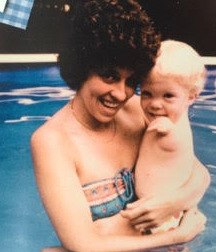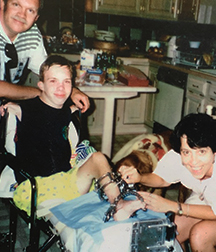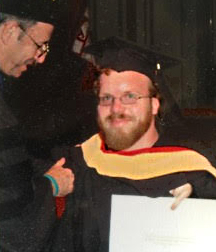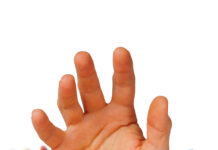When I was born, everyone was expecting me to have arms. My father was perched outside the delivery room in front of a circular window framed in 70s seafoam green, and his view was blocked as I was brought into the world. The doctor’s mind raced: how am I going to tell this mother and father that their son has hands but not arms? Instead of knee and ankle joints I had unfinished blocks of bone and cartilage. The doctor wrapped me tightly in a towel. All my mom could see was my round face and a little bit of platinum blond hair that peeked out. She was expecting me to have dark brown hair like her. She exclaimed, “I can’t believe he has blond hair!” The nurses and doctors looked at each other. They didn’t know how to break it to her. The doctor wondered; if he’s missing so much in his extremities, mustn’t he also be missing a mind?
A nurse came outside to speak to my dad. She told him that everything was fine and I was a healthy baby boy, because only doctors are allowed to deliver bad news. My father’s heart soared with the thought of all the things he would do with his son. Then the doctor came to speak to him. Dad’s mind raced. “What do you mean he has hands but not arms? That’s impossible.” After the reality began to sink in, the doctor asked if he’d like to break the news to my mom or if he would like the doctor to do it. In a state of shock my father shook his head no, and fainted. The nurses handed me to my mother but didn’t want her to remove the blanket, for fear that if she saw my body she would never bond with me.
As soon as t he medical staff left the room, my mom removed the cloth to see what we were working with. “He’ll never be able to hug me,” she said. But my parents made a promise that day that they’ve kept ever since — they would do whatever they could to make sure that I lived a full life. My dad prayed to god, just let him have a mind, and we will take care of the rest. My mom looked into my eyes and knew — in a way that only mothers know — that I had a mind, and spirit.
he medical staff left the room, my mom removed the cloth to see what we were working with. “He’ll never be able to hug me,” she said. But my parents made a promise that day that they’ve kept ever since — they would do whatever they could to make sure that I lived a full life. My dad prayed to god, just let him have a mind, and we will take care of the rest. My mom looked into my eyes and knew — in a way that only mothers know — that I had a mind, and spirit.
My disability was so rare that the geneticists could not diagnose it. But the motivation of a parent for a child should never be underestimated. My mom scoured medical texts and spoke to professionals until she found a group of kids in Boston with the same disability. She brought me back to her local geneticist with pictures of these kids, and after he dusted off one of his medical books and realized that there was a third type of “thrombocytopenia absent radius,” my shape had a name.
I spent the first six months of my life in a full body cast because I was born with dislocated hips (certainly a challenge for parents to diaper). The greatest challenge, however, was managing the reactions of others. People have a very strong reaction to children with disabilities, especially babies. Perhaps, unconsciously, I reminded them that they had the potential to have a child or grandchild that looked like me.
As I began to develop, it became evident that I was comfortable in my own skin because my body is all I know. It’s amazing what people can adapt to. The human mind does not require an ideal body to be effective. However, my family wondered what I might be capable of. They feared that one day I might meet a surgeon who would say, “If you had only come to me as a child, I could have gotten you walking.” They took me to every pediatric orthopedist that they could find on the east coast and even in Toronto. Then they heard that an orthopedist from Boston Children’s had come to the Children’s Hospital of Philadelphia. He had a reputation for using what a child was born with in innovative ways.
 My earliest memories are of that first meeting with Dr. Watts. On the car ride home, my head swam with the recollections of the drawings of what he thought might exist inside my legs, and how it might be used to get me walking. After he thoroughly examined my legs, palpating the unfamiliar, he began to draw. He drew on his knowledge and experience. After he ran out of examination table paper, he drew on his scrubs. I thought about what it would mean to walk. As my parents and I drove over the Benjamin Franklin Bridge, the car began to move up and down as the tires ran over the bridge’s girders. Our two-tone beige Chevrolet began to gallop. I wondered if this was what it felt like to run. I imagined what the individual blades of grass underneath the soles of my feet would feel like. What it would feel like to run on the beach. It felt like freedom. Since then, whenever I’ve had a major life decision about whether to take the safe and known course or the path less traveled, I’ve chosen to take a chance.
My earliest memories are of that first meeting with Dr. Watts. On the car ride home, my head swam with the recollections of the drawings of what he thought might exist inside my legs, and how it might be used to get me walking. After he thoroughly examined my legs, palpating the unfamiliar, he began to draw. He drew on his knowledge and experience. After he ran out of examination table paper, he drew on his scrubs. I thought about what it would mean to walk. As my parents and I drove over the Benjamin Franklin Bridge, the car began to move up and down as the tires ran over the bridge’s girders. Our two-tone beige Chevrolet began to gallop. I wondered if this was what it felt like to run. I imagined what the individual blades of grass underneath the soles of my feet would feel like. What it would feel like to run on the beach. It felt like freedom. Since then, whenever I’ve had a major life decision about whether to take the safe and known course or the path less traveled, I’ve chosen to take a chance.
I leaned forward and told my parents, “I want to walk.”
The ritual of preparation for surgery has been repeated many times in my life. Although that first surgery was just supposed to be exploratory, in my heart it felt like it was my first step. Fortunately for this first surgery, I was blissfully unaware of what the aftermath and recovery would feel like.
Dr. Watts’ first incision was a long one, but he needed to really get an idea of what there was to work with. When he reached inside my leg, he felt bones like he had never felt before. He did not find a kneecap, or any of the other telltale signs of the anatomy that he’d committed to memory. He found unfinished blocks of bone and cartilage that connected the bones of my upper and lower legs. As he looked around he began to see this block not as it was, but as it could be. Like a sculptor who sees the finished product in the raw marble block, he began the work of bringing forth a way for me to walk.
Dr. Watts slowly etched away the cartilage to create a small space. He then drilled screws into the upper and lower leg bones. He attached the screws to halos that went around my leg to hold it in the exact position. A bar connected these halos to each other, with a spacer on each side. Four times a day my parents had to turn the screws a quarter of a millimeter to slowly build on the space that Dr. Watts created, so that there was enough space for my leg to bend. That first surgery was only supposed to take two hours — it ended up taking eight.After the surgery, Dr. Watts exited the OR to report to my parents what had happened. In a state of shock and exhaustion he said, “I can’t believe what I just did.” The attendings who were residents and fellows at the time of the surgery still call it “the miracle.”
I recently spoke with Dr. Watts, 30 years after that first surgery. He told me that before he operated on me that first time, there were many kids he’d chosen not to operate on even though their legs weren’t as involved as mine. He said that in his career he’s found that the biggest predictor of success is how motivated the child and their family are. He told me that on the first day we met, I had as much motivation as any child he’d ever operated on. He thought that if he could get my legs anywhere close to what was needed to walk, I would figure out a way to get it done.
 I spent every summer of my childhood in the hospital receiving surgeries. At that time, pain management was in its infancy. I had three surgeries where I appeared sedated, however I was just paralyzed yet still conscious. It was so traumatic that I couldn’t form words to explain my experience. When I was having flashbacks in the hospital, one doctor told me that only soldiers get PTSD. Years later when I was in the ER and they wanted to put an oxygen mask on my face, I informed them that I had PTSD. They asked me, “What’s PTSD?” I have a migraine that hasn’t left me in 20 years. I have lived with pain so bad that the DEA has issued me my own number to stop the raids routinely triggered by the amount of painkillers I’m prescribed.
I spent every summer of my childhood in the hospital receiving surgeries. At that time, pain management was in its infancy. I had three surgeries where I appeared sedated, however I was just paralyzed yet still conscious. It was so traumatic that I couldn’t form words to explain my experience. When I was having flashbacks in the hospital, one doctor told me that only soldiers get PTSD. Years later when I was in the ER and they wanted to put an oxygen mask on my face, I informed them that I had PTSD. They asked me, “What’s PTSD?” I have a migraine that hasn’t left me in 20 years. I have lived with pain so bad that the DEA has issued me my own number to stop the raids routinely triggered by the amount of painkillers I’m prescribed.
When I was in college, I was on a combination of benzodiazepines and narcotics at doses so high that I would fall on the floor asleep, and even shaking wouldn’t wake me. I’d go home and sleep all day. I had a polypharmaceutical regimen that nobody had studied.
I am a person who is well-versed in navigating medical conditions, the medical system, and pain. But when I crushed my perineal nerve 12 years ago, while in college to become a clinical social worker, the nerve was so damaged that it didn’t come up on an EEG. Doctors told me it was all in my head, even though the geography of my pain perfectly matched a perineal nerve injury. They loaded me up with narcotics and high levels of antidepressants, benzodiazepines and neuroleptics that didn’t help. The doctors thought that if the medication hadn’t yet relieved symptoms, then more of it would, and they went far beyond the levels that would be prescribed for a mental health diagnosis.
There is much talk of evidence-based medicine, but in the real world, doctors — even while dismissing the arguments that medications cause harm as “not empirically validated” — will prescribe medications, dosages and combinations that have never been tested and are therefore, by definition, not empirically (evidence) based. I’m not blaming doctors; I know that this arises from genuine interest in relieving pain, and the faith that there must be some way to do so. I have spent much of my life in hospitals, and they have given me a life that at any other time in history would not have been possible. They are like family to me. But, like family, as much as they want what is best for me, and want me to be happy, and hope to prevent me from feeling pain, they don’t always know how to do this. I’ve seen doctors cry because there wasn’t more they could do for me.
But medication is not always the answer, even if it seems like the only answer — and it is never the complete answer. I am uniquely qualified to say that using medicine as a way to try to eradicate the pain – without paying attention to the broader social and psychological context – is a situation where the left hand does not know what the right hand is doing. In my case, the doctors did not listen to me, and as their interventions increased, the side effects were as bad as the pain. It got so bad that I started cutting myself to distract myself from the pain. When a doctor heard about it, he went to my university and told them to force me out because I was “mentally ill,” even though my grades remained high.
I developed a high temperature, high anxiety, and severe memory problems. I couldn’t remember from one minute to the next what I had just said. I even had difficulty recognizing family members. I suffered from clamminess, trouble swallowing, spasms all over my body, severe GI symptoms (vomiting, etc), severe headache, and difficulty seeing. My pain was so bad, and my heart rate and my blood pressure went so high, that my body thought it was dying and started to shut my organs down. They put me in a coma to stop me from dying.
Eventually a resident realized that it might be neuroleptic malignant syndrome and ripped the IV bag containing the drugs from the stand. His quick thinking saved my life. Upon further reflection they decided that what I’d experienced was a “serotonin storm.” Basically the drugs had created too much serotonin in my brain.
 My support system at college was what pushed me to find answers. Finally I met a doctor who treated me for a nerve injury even though the diagnostic tests didn’t show it. Six years later there were advances in testing that definitively showed a nerve injury. I had a pump implanted in my leg that delivered anesthetic directly to the crushed nerve.
My support system at college was what pushed me to find answers. Finally I met a doctor who treated me for a nerve injury even though the diagnostic tests didn’t show it. Six years later there were advances in testing that definitively showed a nerve injury. I had a pump implanted in my leg that delivered anesthetic directly to the crushed nerve.
Medication can be a powerful tool in the toolbox, but it’s also important to attend to what I call the other half of healing. The psychological, the family, and the social aspect of the experiences that add up to our lives, which includes both love and pain, beauty and sorrow. Medicine can be a piece, but it can never do it alone, because it can’t eliminate pain completely. Life isn’t about avoiding pain; it’s about changing our relationship with it.
Despite my mother’s initial worries, I’ve learned that I don’t need arms to hold people. In fact, when it comes to caring for people, arms can be problematic. They can lead to hurting people, or trying to fix things when it’s really listening that’s needed. I’ve learned to hold people with my presence, and my voice, as they struggle their way through pain and illness. I am a clinical social worker at the Council for Relationships in Philadelphia, where I work with people in chronic pain, people with medical conditions, and people with disabilities — in other words, people. I use hypnosis and mindfulness to manage pain (my own and others’), and I now sleep better and deal with life much better. It doesn’t eradicate pain completely. Nothing does, and the search for something that would nearly killed me. It was the decision I made as a child to pursue a path that would include both pain and the ability to walk that has made me what I am.















Mathew, your story has diminished my capacity to form words.
The world is a better place since I read this.
I can’t wait to hear more from about your work with people who are experiencing a range of mental and emotional issues, including the psychological toll caused by physical pain. My friend David Oak taught me about the importance of a cross disabilities dialogue and I can only hope that you will continue to make your voice heard on this site.
Report comment
My life is also changed by reading your life story, so beautifully and tenderly narrated, dear Matt. I am thankful to your parents and to you for your goodness, wisdom and courage and inspired to see and live differently and with more compassionate wonder.
Report comment
thanks, matthew, for sharing your story. to say you’re truly inspirational is SUCH a cliche, but i’ll say it anyway.
i will be quoting your line ending the second-to-last paragraph, about pain. love it.
keep well,
erin
Report comment
I agree, Matthew, yours is an amazing story. I’m so impressed with all you’ve lived through and accomplished. Definitely brought a tear to my eye. Kudos, and best wishes to you in the future.
Report comment
I see that individuals have a variety of emotional responses to this piece. I am angry that it took so long to convey to your doctors about the level of pain you were experiencing and identify the source (perineal nerve damage). Do you have any advise for me? I am terrified that part if not all of my daughter’s declining cognition, depersonalization, memory loss, inconsistent coherency, dissociation emotional flatness, weight gain and other symptoms are due to several neuroleptics she is court ordered to take. A previous attempt to wean her off a depot injection of a typical neuroleptic, an oral atypical neuroleptic, and a mood stabilizer ‘cold turkey’ by a nurse practitioner in a locked ward resulted in terrible akasthesia, in which she became agitated, aggressive, and assaultive. They quickly put her back on the depot typical neuroleptic at an even higher dose, augmenting it with another typical neuroleptic. When we, the parents, express our concerns as diplomatically as possible, we are painted as ‘disruptive’ and ‘in denial’. This nonsense about our being ‘in denial’ made it into a ridiculous court document that severely limits her ability to live at home in a safe and supportive environment while seeking alternative treatments, even though she has expressed this desire for the better part of the last two years. I’m afraid my daughter is caught in a catch 22 and there are no supports to help individuals safely wean off these dependency forming meds.
Report comment
I find what you and your family are being forced to suffer through unbelievably horrific. Is there no way of legally arguing to have the court document changed so you could support your daughter at home? Although we dont have a lot, I would certainly (annoyomously) contribute to a fund supporting legal fees for your daughter’s case and I bet a lot of other people would too.
Report comment
Thanks for the kind words
Report comment
A very inspiring story, Mathew, and a testament to the importance of accepting pain in life, while building in respect and compassion. Come on, everyone, let’s make this touching and important blog go viral.
Report comment
Extremely inspiring. Your video is wonderful. You had some great guidance, your parents sound very wise, and wonderful role models and teachers in how to deal with an often cruel world.
Thank you for demonstrating clearly that with the right attitude and encouragement, we are truly limitless human beings; and for being such a shining example of “originality, passion, and care…”
Report comment
Hi Matthew
I will as many others also say how inspiring your story is. I love that you had a family who saw the potential in you and not what you could not do. Why are we not doing this with everyone?
I am outraged that you too were subjected to this narrow, narrow little world where the solution is pills and more of them and in your case you cold have died or been left with permanent brain damage. I appreciate many doctors are trying to help but their tool box has become so impoverished that if all you have left is a hammer then all you are going to see are nails.
I am so sorry you too had to go through that but how wonderful it was then to see your video and see you well and strong and finding ways to live your life help others and I love your karate story so you too could defend your self.
An inspiration!
Report comment
“I love that you had a family who saw the potential in you and not what you could not do. Why are we not doing this with everyone?”
That is my burning question, always. I can’t help but to get inscensed when I hear a prognosis of “you will always be limited.” If anything causes chronic disability and does equally great harm to families and to the fabric of society, that has to be at the top of the list.
I believe it merits repeating, “Why are we not doing this with everyone?” From your lips to God’s ears.
Report comment
What an exquisite essay, a gift to the world. Thank you for what you wrote and who you are.
Report comment
Matthew, my name is Eric Millen and I have worked at an Agency that provides supports for many people who have faced and continue to face a variety of challenges as a result of their bodies and minds work. They also face challenges that are created by society, a society that often judges and works against hope rather than to create and cultivate hope. I have worked in Human Services for 28 years and during this time I often forget many of these individual and societal challenges faced by those to whom I work to help. Reading your story and viewing your video of how you and your parents approached the numerous mountains you have climbed in your lives has helped me to be re-energized and to have a renewed perspective on how to approach my work. Thank you for sharing your remarkable story of courage, persistence and achievements! Best wishes!
Eric Millen
Report comment
Please consider the following as a front page article on Post Traumatic Stress Disorder –
The Transcendental Meditation program has been endorsed by the U.S. Department of Veterans Affairs (VA) for over 20 years for soldiers with PTSD.
Kindly watch and share with all –
“PTSD and Transcendental Meditation – David George, Infantryman” (2:34;https://www.youtube.com/watch?v=6ki4c-XkYsM / excellent!)
and
“Transcendental Meditation Improves Performance at Military University” (5:12;https://www.youtube.com/watch?v=oIH0913lQe0 )
Also see, “Use a Treatment for PTSD That Actually Works” in The Hill, Washington DC
http://thehill.com/blogs/congress-blog/healthcare/262340-use-a-treatment-for-ptsd-that-actually-works
and
“Transcendental Meditation May Reduce PTSD Symptoms, Medication in Active-Duty Personnel” in EurekAlert (01/11/16)
http://www.eurekalert.org/pub_releases/2016-01/mcog-tmm011116.php
Thanks!
Bill @ BillsArtBox.com
P.S. Please visit http://www.operationwarriorwellness.org/ for more information.
Note: Results are available for long-standing PTSD symptoms, as well, including for Vietnam Veterans.
Also, see the dramatic effects for Domestic Post-Traumatic Stress Disorder for women and children, and for PTSD for “First Responders”, at http://www.davidlynchfoundation.org/#video=6gM_sXiUPvo (5:24)
Also, from http://www.army.mil/ :
“Transcendental Meditation – a Path to Healing”
“Doctors promised him through medication and hard work he could potentially heal over the course of years, but since transcendental meditation he has moved much closer to achieving his recovery in months.”
Report comment